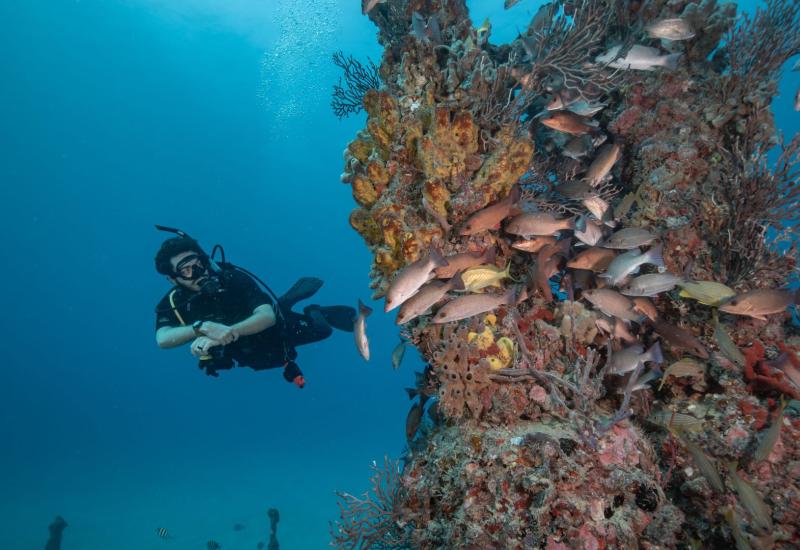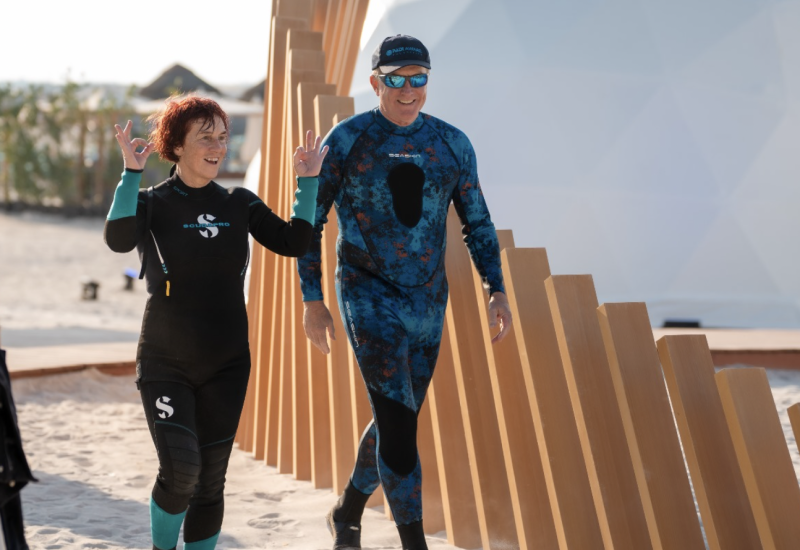What It's Like to Be an Underwater Photographer in Ningaloo Reef
_originala9a3.jpg?itok=iWucs_H0)
Courtesy, Oliver ClarkeBrooke Pyke swimming alongside a whale shark on the Ningaloo Reef
A post-graduation trip in 2011 to Thailand changed Brooke Pyke’s life. She came home to Melbourne, Australia with her open water certification card in hand, and immediately started saving to complete her divemaster training.
Today, she is a self-taught photographer and photo trip leader, who shoots images of marine life as well as adventures above and below the waterline.
What was the transition like between divemaster and photography?
I started my PADI professional career as a divemaster in Thailand, then worked on the Great Barrier Reef and in Bali. On Nusa Lembongan, a small island off Bali,I became a PADI Instructor. I lived and worked there for four years, and in my spare time, I picked up a point-and-shoot camera and taught myself how to use it.

Courtesy Brooke PykeA giant oceanic manta ray cruises over the white sand of the Ningaloo coast.
When did you start getting paid to take photos?
I was working as a dive instructor in Lembongan and the dive center asked me to start creating photos for them to use on social media. This is where I realized I wanted to turn my hobby into a professional role full time instead of teaching diving.
I moved to Ningaloo Reef in 2021 begin my new career path as it is a hotspot for photography. I found a job on a day boat that takes people snorkeling with whale sharks.
That led to working five days a week in the ocean. My job is to get a photo of each guest with a whale shark, in addition to photos of them on the boat throughout the day.
What was the hardest part of the job?
People don’t realize how physical the job is. It’s a lot of swimming. The guests get picked up by the boat and dropped closer to the whale sharks again and again. But the guides stay in the water the whole time, swimming 1 to 2 hours.
We also have to help people get in position alongside the whale shark to get the photo. Guests have various swimming abilities, so often I am towing someone up to the whale shark while also dragging my camera. The job keeps you very fit.
Related Reading: Dangerous Jobs: Diving With Alligators and Crocodiles
What has been your most memorable encounter?
We sometimes get krill formations off Ningaloo, especially after the coral spawn. This is one of the main reasons whale sharks gather on the reef, but I remember one day of pure chaos when seven whale sharks showed up to feast on a dense krill cloud.
It was absolute chaos. Animals darted around me so quickly, but I could only see a few meters ahead because the sea was so thick with krill.

Courtesy, Brooke PykeWhale shark in a cloud of krill.
More than a few times I glanced in one direction only to see a whale shark barreling toward me, and have to rush to get out of the way. I ended up with mostly blurry photos of sweeping tails and gaping mouths. I didn’t get amazing photos but the experience was one I will never forget.
How did you transition to fine-art photography?
Because of where we are and what I do, I get a lot of opportunities to shoot at my day job. Most of my job consists of photographing the customers, but I do get a bit of time to take my own photos. I also have my own boat that I take out. Every day, I take about 300 to 400 photos, and end up with maybe one fine-art shot a week that I really love.

Courtesy, Brooke PykeA tiger shark feeds on a whale carcass on the sea floor.
What has been your most surprising encounter?
Last year, some friends got word that a whale had died in the bay. They found the body on the sand at 32 feet and shared the GPS coordinates with us. By the time we got there, tiger sharks were taking turns stripping flesh from bones, and not much more than a skeleton remained.
It was very sad and felt profoundly real, but it’s just nature doing its thing. It was scary because of the tiger sharks feeding, but also incredibly beautiful.
What’s the most rewarding part of your work?
I love teaching others how to shoot on the photography trips that I offer. I clearly remember my own struggles early on, so it’s rewarding to help people conquer these skills.
In my experience, diving is such a male-dominated sport. I guide many women on my trips, and I hope their experience with me inspires more to assume roles in this industry.
Related Reading: World's Best Destinations for Underwater Photography
How has your work supported conservation?
When I first started underwater photography, I encountered a lot of marine debris off Bali, right where manta rays would often feed. I took several images of mantas surrounded by dense plastic, and one eventually got picked up by newspapers.
I received countless emails and messages on social media from people who insisted the photo was fake, which opened my eyes to how many people were unaware of the devastating human impact on the environment. I learned then that photography can be a bridge that brings people front and center to these issues.

Courtesy, Brooke PykeA clown fish living amongst the tentacles of its bleached anemone home.
How else have your photos inspired people?
I receive messages from people who live in the city but after seeing my marine life photos, they felt such a connection to the animals that they had to come to Ningaloo Reef to see them in real life. Sometimes people book the day boat that I work on after seeing my photos.
What’s the hardest part of being a photographer?
It’s very expensive and a huge time commitment. People often see my photos and think that all I do is travel and spend time on the water, but I spend hours editing, emailing, keeping up with administrative work and my social media accounts, and I have also invested a lot in gear and editing software.
The conditions can also be quite stressful on Ningaloo Reef when you’re trying to work, because 9 times out of 10 it is windy with big swells. But no matter how exhausted I am at the end of the day, the adventure is always worth it.
See more of Brooke's art at www.brookepykephotography.com and follow her on social @brookepykephotography.










